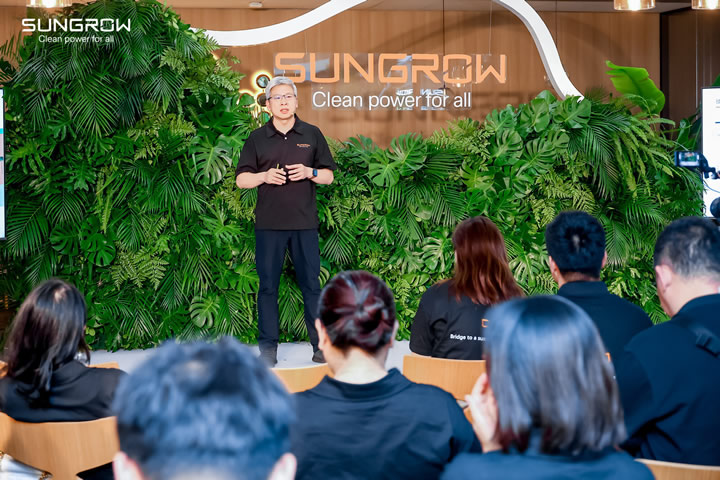Sungrow Shares 10 Major Technological Trends in Renewable Energy Industry

Sungrow, the global leading PV inverter and energy storage system provider, shared 10 major technological trends at the recent Ph.D Talk event in Shanghai. With an investment of 2.45 billion yuan (approximately 347 million) in R&D throughout 2023, the company stands at the forefront of technological innovation. Embracing their brand-new tagline "Bridge to a Sustainable Future", Sungrow is dedicated to bridging the gap and making clean energy accessible to everyone.
Ph.D. Xu Jun, Vice President of Sungrow Research Center, highlighted 10 Major Technological Trends at Ph.D. Talk:
- The Application of New Semiconductor Devices
To achieve net-zero carbon emissions, advancements in energy generation, transmission, and conversion efficiency are crucial. According to Diamfab, diamond has the potential to become the ultimate WBG semiconductor material for high-power electronics. Diamond possesses ideal characteristics for high-voltage operation, high-temperature applications, and high-frequency switching, with a critical electric field 30 times higher than Si and 3 times higher than SiC.
- The Extended Utilization of Solid-State Transformer (SST) Technology and Medium-Voltage Photovoltaic (PV) Inverters
The medium-voltage PV power generation system based on SST technology offers a higher power density compared to traditional solutions, with an overall improvement in conversion efficiency. In the future, SST technology may find applications in MW-level charging stations, HVDC power supply systems for data centers, energy routers, and more. Notably, Sungrow developed the world's first 35kV SST-based PV inverter in 2022.
- Further Enhancement of Direct Current (DC) Voltage Level in PV Systems
The increase of DC voltage in PV systems not only increases power density and efficiency but also reduces infrastructure and maintenance costs. Notably, Sungrow achieved a groundbreaking milestone by becoming the world's first company to introduce the 2000V solar-plus-storage high-voltage system and successfully integrating it into the grid in Yulin, Shaanxi.
- Improving the Overall Lifecycle Efficiency of PV Power Plants through Digitization and AI
Sungrow has introduced the concept of DEPCO (Development, Engineering, Procurement, Construction, Operation), bringing about comprehensive digitization to renewable energy power plants. The company has developed cutting-edge software solutions, namely iSolarTool for optimizing the design of large-scale PV power plants, and iSolarBP for commercial and industrial PV assessment and design. By leveraging AI intelligence, these innovative tools enable end-to-end system optimization, effectively boosting the efficiency and profitability of renewable energy development. Currently, these solutions are in the industry trial phase.
- "PE Agent," a Power Electronic Designer Based on Large Language Model (LLM)
During the energy transition, AI intelligence will play an increasingly significant role. PE Agent can facilitate seamless communication between AI and AI, as well as between AI and humans, enabling intelligent management of the entire process of power electronics design and achieving "self-learning" and "self-evolution."
- High Voltage Direct Current (HVDC) Technology
HVDC systems provide faster active power flow control compared to the more established CSC-HVDC technology. Additionally, they offer flexible and enhanced reactive power controllability at both converter terminals.
- Source-Grid-Load-Storage Integration: Driving the Rapid Development of Energy Bases and Future Urban Construction
The construction strategy for the source-grid-load-storage operation mode in renewable energy integration can leverage multiple energy sources, enhance grid capacity for renewable energy integration and economic efficiency of active distribution grid operations.
- Grid-Forming (GFM) Technology
GFM technology provide rapid, accurate, and standardized dynamic responses to grid faults and disturbances. It offers strong support for the stable operation of new power systems in various application scenarios.
- Virtual Power Plants (VVPs)
VVPs are networks comprising small-scale energy-producing or storage devices, such as solar panels and batteries, that are aggregated to serve the electricity grid. With the consent of their owners, the energy generated by these devices can be accessed by utilities during periods of high demand or saved for future use.
- Green Hydrogen
The off-grid solar-hydrogen solution, IGBT-based hydrogen production rectifier power supply, and the integration of hydrogen for complete energy self-sufficiency in residential buildings with PV and battery storage systems can further enhance energy efficiency.
Comments (0)
This post does not have any comments. Be the first to leave a comment below.
Featured Product

